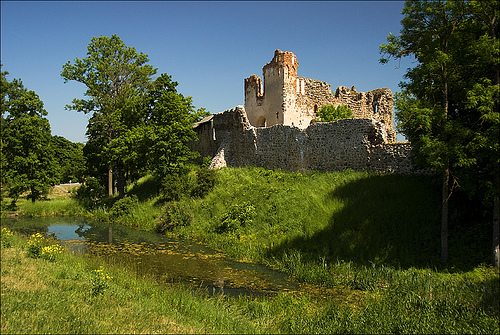

Location: Zemgale region Map
Constructed: 1335-1339
Dobele History Museum
Brivibas 7
Tel. 6372 1309
Open: 12pm- 6pm Wed
11am- 4pm Thu- Sat
Dobele stone castle replaced a earlier wooden citadel from the 13th
century that was constructed here by the Semigallians. After
Northern Crusades added these lands to the Catholic sphere of
influence Crusaders needed a chain of military fortifications to
defend their newly acquired lands. Northeast Europe at the time was
still followed pagan cults. Dobele Castle is located in Zemgale
region of Latvia was constructed in 1335- 39 by knights of the
Livonian Order. It was further increased in size and strength in
1345. The castle consisted of four buildings that surrounded a
courtyard. Additionally a church stood inside the walls. Western
rectangular tower also served as the gate to the whole compound. In
1620 the Swedish army under leadership of Gustavus Adolphus captured
the Dobele Castle. Between 1643 and 1649 Duke Frederick's widow
Elizabeth Magdalena lived here. During Northern War King of Sweden
Charles XII stayed here.
Many legends are associated with
the Dobele Castle. One of the legend state that one tunnel lead to
Lielberze, while another leads under the river Berze. Another legend
claim that the copper roofs of castle sparkled so intensely it was
visible far in the Baltic Sea. Many trader's ships mistook this
light for a lighthouse and changed their course toward it. Many
sailors and traders died crushing on the rocks. Their curses
eventually caused a huge hurricane that blew off the copper roof
from the building. Over time the castle lost its military importance
and gradually fell in disrepair. In 1730 its roof collapsed and the
structure was abandoned. The castle restoration started in 2001 to
keep the overall structure intact.
History
Dobele Castle was first mentioned in documents in
1254, when a fortified wooden castle existed in this place - the
administrative center of Zemgale Dobele Castle District. During the
Livonian Crusades, fierce battles with German crusaders took place
in the Dobele area. Zemgale showed great resistance to the enemies,
who were also unable to occupy the castle. From 1279 to 1289, Dobele
Castle withstood six sieges of the Livonian Order. When the whole
area was destroyed, the Semigallians burned their own castle in 1289
and went to the territory of the Grand Duchy of Lithuania without
victory.
In the winter of 1345, the Lithuanian nobleman
Algirdas, together with Kestutis, invaded Zemgale, captured Tērvete
Castle and set fire to Jelgava Castle, but in 1346 destroyed
Mežotni. Perhaps Dobele was also attacked during this time. From
1335 to 1347, the Livonian Order built a stone castle on the site of
the burned Semigallian castle, around which a settlement of
craftsmen and merchants was formed over time. 1376.-1562. In the
castle stayed in the castle Dobele commanders with their military
congregation. The last commander of Dobele Matīss from Reke came
into conflict with the Duke of Courland Gotthard Kettler, who in
1566 occupied the castle and forced the commander to abandon it.
In 1579, 1613 and 1628, the Kurzeme Landtags were held in Dobele
Castle. 1620./1621. and in 1625 Dobele was occupied by the troops of
King Gustav II Adolf of Sweden.
From 1643 to 1649, the castle
was inhabited by Duke Friedrich's widow Elizabeth Magdalene with her
foster son Prince Jacob (later Duke Jacob). In 1658, during the
capture of Duke Jacob, the castle was acquired by the Swedes. In the
same year, the people of Kurzeme, together with the Poles, tried to
capture the castle, but did not hold back and were expelled again.
In 1660, after the Treaty of Oliva, Duke Jacob regained the
castle and a long additional building was built on the eastern wall
of the castle, but the castle fortifications were not restored. In
1701, the castle was again occupied by the Swedes and King Charles
XII of Sweden stayed in the castle for 6 days. During the war, the
city and the castle were badly destroyed. 18th century In the first
quarter, plague broke out in and around Dobele, significantly
reducing the population. The castle was inhabited until 1736, when
its roof was invaded.
On June 24, 1870, the Kurzeme Latvian
Song Festival took place near the ruins of Dobele Castle - one of
the first in Latvia, because the first general song festival took
place in 1873. In 1915, at the foot of the castle, military debts
were accepted by the German Emperor Wilhelm II.
In 2018, the
preservation of the ancient walls, the restoration of part of the
castle convent building, as well as the construction of a
multifunctional exhibition hall, exposition and viewing area began.
During the construction works, an intact cultural layer was
discovered at the entrance to the chapel basement, which included
Semigallian rings, brooches, bells, pendants, spiral, chain jewelry
fragments, hand bracelet fragment, beads, buckles, spokes,
spearheads, crossbows, crossbows, arrow snippets, fishing rods, lead
sinks and even hazelnuts.
Stories
Two underground passages
led from the castle - one to the left bank under the bed of the
Bērze River, the other - to Lielbērze.